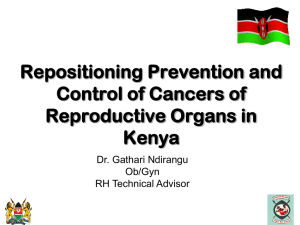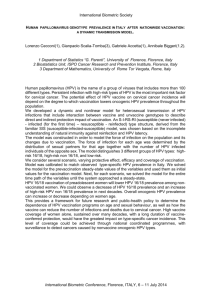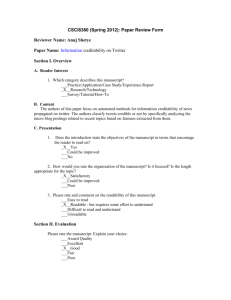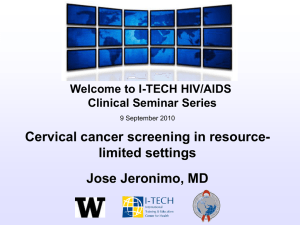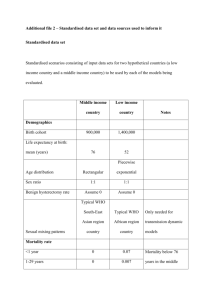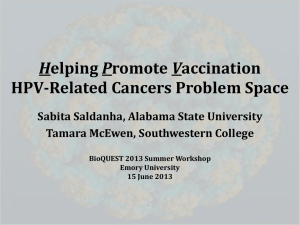Draft Letter on Sue`s Letter Head for Julia
advertisement
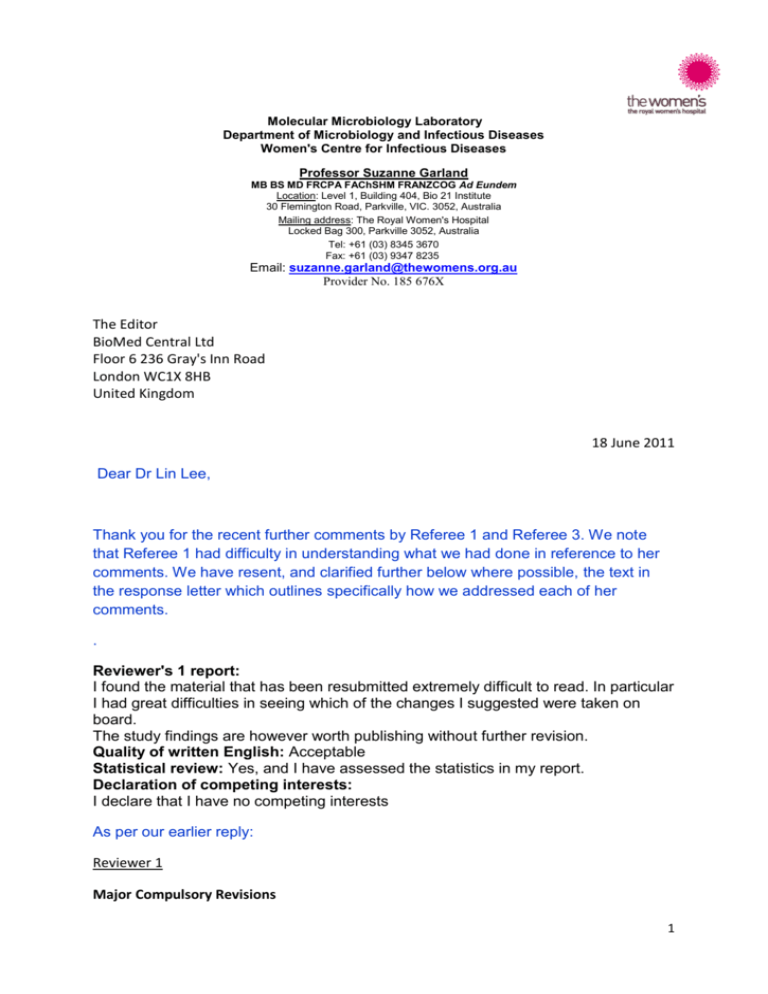
Molecular Microbiology Laboratory Department of Microbiology and Infectious Diseases Women's Centre for Infectious Diseases Professor Suzanne Garland MB BS MD FRCPA FAChSHM FRANZCOG Ad Eundem Location: Level 1, Building 404, Bio 21 Institute 30 Flemington Road, Parkville, VIC. 3052, Australia Mailing address: The Royal Women's Hospital Locked Bag 300, Parkville 3052, Australia Tel: +61 (03) 8345 3670 Fax: +61 (03) 9347 8235 Email: suzanne.garland@thewomens.org.au Provider No. 185 676X The Editor BioMed Central Ltd Floor 6 236 Gray's Inn Road London WC1X 8HB United Kingdom 18 June 2011 Dear Dr Lin Lee, Thank you for the recent further comments by Referee 1 and Referee 3. We note that Referee 1 had difficulty in understanding what we had done in reference to her comments. We have resent, and clarified further below where possible, the text in the response letter which outlines specifically how we addressed each of her comments. . Reviewer's 1 report: I found the material that has been resubmitted extremely difficult to read. In particular I had great difficulties in seeing which of the changes I suggested were taken on board. The study findings are however worth publishing without further revision. Quality of written English: Acceptable Statistical review: Yes, and I have assessed the statistics in my report. Declaration of competing interests: I declare that I have no competing interests As per our earlier reply: Reviewer 1 Major Compulsory Revisions 1 This is a very interesting piece of work that shows lack of substantial difference in HPV prevalence between indigenous and non-indigenous women in Australia despite a severalfold difference in cervical cancer incidence between the two groups. The present findings seem to agree with a pooled analyses of international HPV prevalence surveys and case-control studies carried out at IARC (Franceschi et al, Brit J Cancer, 101, 865-870, 2009) that suggested that low education level (as a proxy for socioeconomic status) was associated with increased cervical cancer risk but not with higher HPV prevalence. In addition to different screening uptake, substantial part of the difference in cervical cancer risk by education level in the paper by Franceschi et al (2009) was explained by earlier age at first sexual intercourse and first birth and by higher parity in the least educated women. The authors should consider that paper and check whether similar differences in age at first sexual intercourse and first birth and parity existed between indigenous and non-indigenous women in Australia. Thank you; we had already considered the higher fertility rate, young age at first intercourse and birth of Indigenous women in the second paragraph of the discussion. We have now added in the suggested reference page 35 paragraph 1 ‘….incidence and mortality observed in Indigenous women.[21,31] Franceschi et al have previously found that lower education levels (as a proxy for socioeconomic status) are correlated with cervical cancer risk but not increased HPV prevalence and may be mediated through risk factors such as earlier age at first intercourse and higher and earlier parity. [32] Regardless of the underlying reasons, the presence of other high risk HPV DNA types To a large extent, the present findings by Garland et al, similarly to those by Franceschi et al, challenge the concept that an association of low socio-economic class or ethnic group explain to any great extent differences in cervical cancer risk. Another aspect the authors should address is whether the recruitment modality (i.e., through community-based clinics rather than GPs) might have led to a substantial difference in the selection of indigenous and non-indigenous women (e.g., selection of non-indigenous women at higher risk for STIs). Thank you for this observation. We do recognize, as stated in the manuscript, that the sample is not geographically or demographically representative of the Australian population. It is indeed likely that the non Indigenous women recruited in the study, are of lower socioeconomic status than average, given that they are accessing free community health services rather than general practitioners, but that they will still be on average of higher socioeconomic status than the Indigenous women. We have added a sentence highlighting this point to paragraph four (page 36) of the discussion. ‘Non-Indigenous women attending free community health services are likely to be of lower socioeconomic status on average than other Australian women.’ 2 In tables 1 and 2 it would be interesting to add, in addition to age at first sexual intercourse and first birth and parity, time since last smear, if the information is available. Unfortunately this data is not available (as outlined in the methods) Tables 3, 7, etc: I strongly recommend to always adjust for age and ignore crude ORs. These have been deleted from TABLE 3 (now TABLE 2). We prefer to leave this in table 7 now TABLE 6). etc as shows the impact of age. MOST IMPORTANT: authors should be extremely careful in over interpreting differences in the prevalence of HPV types between cancer-free indigenous and non-indigenous women in Australia as evidence of different HPV 16/18 vaccine efficacy. They should clearly state that HPV 16/18 vaccine efficacy is ultimately due the ability of the vaccine to prevent cervical cancer and, therefore, the most important thing would be to compare the distribution of HPV types in cervical cancer in the two groups. We believe that we have been appropriately cautious throughout the manuscript but in order to avoid any misunderstanding have changed the following line in the third paragraph of the introduction (page 6): was ‘Should types causing disease differ amongst Indigenous women,…’ now reads ‘Should the prevalence of vaccine preventable types differ amongst Indigenous women,…’ Minor Essential Revisions Abstract: give age range CHANGE <41 TO 17-40 YEARS This has been done: line 1 of methods of abstract page 12-13: please clarify the use of AMPLICOR: it seems to me that eventually both AMPLICOR-positive and AMPLICOR-negative women were genotyped using LA. As per the methods, page 12 all AMPLICOR positive samples were genotyped by LA. For those negative by AMPLICOR, we used an in-house assay as this has the ability to pick up more than the 13 high risk types and as previously published. As the Amplicor HPV test only detects 13 HR-HPV, in order to rule out presence of other types, all samples testing negative for HR-HPV by Amplicor HPV test, were tested using a 20 μl aliquot of extracted DNA by PGMY09/11-based HPV consensus PCR.[28] A PCR ELISA detection, as described previously, was utilized.[29] All assays utilized incorporated the amplification of ß-globin gene as an internal control. page 9: specify if +/-5% refeRs to the aboslte percent. 3 Yes it is absolute and it has been added to clarify this point: “Page 9 ….for a Pap smear and was powered (alpha 0.05, 1- beta = 0.90) to detect an absolute difference in HPV16/18 of +/-5% or…..” Discretionary Revisions Omit, please, the first 3 lines of the Introduction. As suggested this has been omitted from the first part of the Background By and large, I believe that there are some repetitions in the text and in tables that should be avoided for brevity sake. Table 1 and 2 may be merged. Table 4b can be eliminated. We have reviewed the text for repetitions or wordy comments and reduced accordingly throughout the paper. For example page 7 Background has been modified to ...12-year-old girls as an ongoing program, with a catch up program delivered through school and community providers for women up to 26 years of age which finished December 31, 2009.” to reduce words. Similarly in the methods page 10 words reduced to “Women were asked to allow the cervical samples collected for Pap cervical cytology to be also tested for HPV DNA. Once fully informed consent was obtained, Pap smear samples were collected in the routine clinic settings. In addition to routine pathology specimen details, information We have merged tables 1 and 2. We could delete 4b (now table 3b), although this is the table showing all the types by Indigenous and NI status, so would prefer to keep it. We have deleted Table 6 and the text (paragraph pages 25-26) that described this. As noted previously, we have put the Reviewers comments in bold, and answered under each of them in italics, where we have modified the manuscript. Reviewer's 2 second report The investigators have provided an improved revised manuscript. However some questions still remain. Major: The section on HPV testing needs to state the QC practices and how contamination was evaluated. 4 To address this, we have added the following statement on page 12, final paragraph before Statistical analysis. ....“Specimen contamination and carryover were prevented by using barriered tips, prior aliquoting of all reagents, and performing pre- and post-PCR steps in different rooms specifically allocated for PCR. Negative and positive controls were processed with each run and lack of signal in the negative control was used to monitor possible carryover.” Importantly, what was the agreement between Amplicor and Linear Array, for positive/negative and by type? As previously mentioned the detail between the different assays and cytology is the focus of our next manuscript. However to summarise here and answer the question, we have added the following on page 15 , last paragraph. “It is to be noted that overall 1.7% of the Amplicor positives could not be confirmed by LA and the in-house assay: hence these were deemed as negative on genotyping” Table 2. It would be preferable to present the actual data. The Population standardized prevalences for indigenous women should be a separate or supplemental table. We believe this is a decision for the editor actually as we removed this data in response to Reviewer one’s comments – it is to be noted that Silvia suggested ONLY presenting adjusted figures. Table 3a should be deleted, as the data is contained in Table 3b. This has been deleted as suggested by the reviewer; consequently table 3 b now becomes 3. It appears that the indigenous women have a U-shaped curve of HPV prevalence that is seen in other populations. The investigators should note and comment on this. This has been addressed in the Discussion page 34, second last paragraph, stating the following: It is to be noted that for this population up to 40 years, the indigenous women had a U-shaped curve of HPV prevalence. This has been described in other populations, with hypotheses for its occurrence including changes in sexual behaviour with age, reactivation of latent infection and a cohort effect.(new reference 34 here: Burchell 5 AN, Winer RL, de Sanjose S, Franco EL. Chapter 6: Epidemiology and transmission dynamics of genital HPV infection. Vaccine 2006;24S3:S3/52-S3/61.) Minor: Table 5. P-values are not necessary, since confidence intervals are provided. Our Epidemiologist prefers to keep both Please define “Victorian” women. On page 14, last paragraph, third last line, the following has been modified to explain what represents the State of Victoria …… ‘Victorian Cervical Cytology Registry, which services women resident in the state of Victoria, Australia, representing a population of 2.7 million females, on the age-adjusted prevalence of detection of Discretionary: It was disappointing that the authors are not presenting the association of HPV and cervical pathology in this manuscript. As was previously advised this is the topic of another manuscript which has already been written is ready for submission plus has the focus of cervical cytology comparison of the various assays. As previously, we enclose a marked up copy (with the previously made changes from round 1 of reviewers’ comments) plus the second round whereby we have coloured these changes in yellow to make it easier to find and for reading the manuscript. In addition, we have submitted a manuscript with all of the changes accepted. We hope this suffices now for publication. Regards, Professor Suzanne M. Garland. Head of Clinical Microbiology and Infectious Diseases Royal Women’s Hospital, Senior Consultant Microbiology, Royal Childrens Hospital Honorary Research Fellow, Murdoch Children’s Research Institute Professor Department of Obstetrics and Gynaecology 6 University of Melbourne Past and Inaugural President of AOGIN (Asia Oceania research organization on Genital Infections and Neoplasia) Tel: + 61- 3 - 8345 3670 Fax: +61 (03) 9347 8235 7



